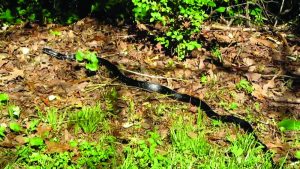
It’s late spring already and just imagine one morning wandering around your garden enjoying your beautiful flowers with a cool drink in hand. You can hear the birds singing, feel a gentle breeze, and maybe even a sprinkle or two of rain…a garden moment. Then you see something moving quickly through the grass into the shelter of nearby plants and your garden moment is lost. Or is it? I say “good morning, Henry” to my five foot black snake that’s been a part of WillowDale’s Wildlife Habitat for at least 10 years; and, based on his size, probably longer.
Henry is a black racer snake (Coluber constrictor) one of the two species of non-venomous black snakes in the upstate area. When I encounter him, he vanishes quickly to some other area of the garden thus the name ‘racer’. He is slender and a dull black color with white stripes on his chin and his species can be found in most gardens, fields, trees and roads. He feeds on insects, smaller snakes, voles and other animals that can destroy our gardens. I see him quite often in our bog garden where hostas and other plants flourish in the damp, organic soil. Unfortunately, our bog garden has been a feeding area for voles. But not with Henry around who has since eliminated them giving me strong and beautiful hostas.
The other species of the black snake is the black rat snake that also grows to about five feet and is shiny black in color with a blotched pattern. One of the interesting differences is their reaction when encountered by us. The rat snake will typically remain rather stationary or moves slowly as if he is contemplating what to do, where do I go? But don’t underestimate him for he is very agile and can climb mature trees and feast on full grown squirrels. His habitat and feeding requirements are similar to Henry. And like all wild animals they can bite, so keep your hands away from their mouth and you’ll be fine.
Both the black racer and rat snake have a job to do in our gardens and would just as soon not encounter you as much as you don’t want to encounter them. Thus, this mutual understanding is beneficial to the snake, our garden, and us by allowing them to roam the area and feed. It is a myth that black snakes kill poisonous snakes but they do eat their food sources and no food keeps others away. So, the next time you see a black snake just step aside, let him do his thing, and enjoy your garden moment.
For I say, “Bon appetit, Henry!”♦

